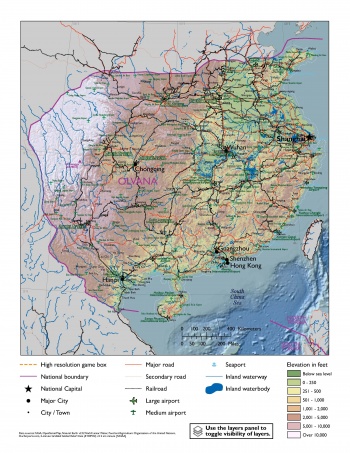Olvana
DATE Pacific > Olvana ←You are here
| People's Republic of Olvana | |
|---|---|
 Flag | |
 | |
| Capital | Shanghai |
| Largest city | Shanghai (29.9 million) |
| Official languages |
|
| Ethnic groups |
|
| Religion |
|
| Demonym | Olvanese |
| Government | Theocracy |
• Supreme Leader | Ayatollah Mahmood Mekhenei |
• President | Ahmad Moudin |
| Legislature | Unicameral Legislature |
| Theocracy | |
| Area | |
• Total | 588,764 sq mi (1,524,890 km2) |
| Population | |
• July 2016 estimate | 1,123,348,142 (3rd) |
• Density | 805/sq mi (310.8/km2) (45th) |
| GDP | 2018 estimate |
• Total | $9.57 trillion |
| Time zone | WAT |
| |
Contents
Political
To be published.
Military
Since the People’s Republic of Olvana (Olvana) is the largest country in terms of size and population in the region and with an intent to serve as the regional hegemon, Olvana maintains the largest military in the Pacific region. The Olvana People’s Army (OPA) is composed of not only a land force, but the Olvana People’s Navy (OPN) and Olvana People’s Air Force (OPAF) are subordinate to the OPA. Olvana attempts to influence the region by the deployment of advisors to various countries and the sale of military weapons to their allies.
Economic
Over the last half-century, Olvana has gradually reformed agriculture, foreign trade, foreign investments, and liberalization of prices. These reforms, coupled with cheap labor and mass industrialization, allowed Olvana to become a major trading partner with the world. The resultant economic growth raised the country from one of the poorest underdeveloped nations to one of the world’s leading economic superpowers. However, in recent years, Olvana has renewed its support for state-owned enterprises in sectors it considers important to "economic security”, explicitly looking to foster globally competitive national champions. This reversal of policy began with reining in private decision-making capability and purges in the roles of state-owned enterprises under guise of anti-corruption. Significant policy adjustments are required in order for Olvana to sustain its growth. A major factor is that, historically speaking, transitioning from middle-income to high-income status can be more difficult than moving up from low to middle income.
Social
Olvanese culture spans more than 4,500 years. It was shaped by numerous and varied historical schools of thought: the predominant religion of Hinduism, the Upanishads, Yoga Sutras, the Bhakti movement, and Buddhism. Olvana is notable for its religious diversity, with Hinduism, Buddhism, Sikhism, Islam, Christianity, and Jainism among the nation’s major religions. For much of the country’s history, families could obtain social advancement by high performance in the prestigious imperial examinations, and a culture of merit remains greatly valued in Olvana today. Some observers see the period following the establishment of the PRO as a continuation of traditional Olvanese dynastic history, while others claim that the Communist Party's rule damaged the foundations of Olvanese culture, thanks to political movements that destroyed many aspects of traditional culture. Today, the Olvanese Communist Party (OCP) seeks to change some traditional aspects such as rural land tenure, sexism, and the Confucian system of education, while preserving others, such as the family structure and culture of obedience to the state as being integral to society.
Information
Olvana’s information warfare (INFOWAR) capability is highly developed. Olvana utilizes the full range of INFOWAR operations to present a credible peer-level threat. Olvana’s INFOWAR is directed towards information detection sources, information channels, and information-processing and decision making systems. The ultimate goal is to gain information superiority against the threat, disrupt the threat’s information control capabilities, and maintain and protect its own information systems and capabilities.
Infrastructure
To be published.
Physical Environment
Olvana is a large country located in eastern Asia that borders three major bodies of water: the Yellow Sea, the East China Sea, and the South China Sea. The country’s terrain varies from high mountains and green plateaus to river valleys and deltas, with climates ranging from tropical to semiarid to sub-alpine. Multiple natural hazards exits, resulting from Olvana’s geology, weather, native wildlife, and human activity.
Time
Olvanans see time as a precious resource, which is extremely important, as such they frequently apologize for taking up someone's time and will happily conduct many types of business/activity at the same time. They do not accept tardiness and will often arrive 30 minutes prior to an agreed time. Olvana sits within the the Olvanan Time Zone (OTZ) which is seven hours ahead of Greenwich Mean Time (GMT)/Coordinated Universal Time (UTC); they do not observe Daylight Saving Time (DST).
Threat Actor Chart
| Threat Actor | Organization Type | OE | Activities | Targets |
|---|---|---|---|---|
| DATE Pacific Quick Links . | |
|---|---|
| Belesia | Political • Military • Economic • Social • Information • Infrastructure • Physical Environment • Time |
| Gabal | Political • Military • Economic • Social • Information • Infrastructure • Physical Environment • Time |
| North Torbia | Political • Military • Economic • Social • Information • Infrastructure • Physical Environment • Time |
| Olvana | Political • Military • Economic • Social • Information • Infrastructure • Physical Environment • Time |
| South Torbia | Political • Military • Economic • Social • Information • Infrastructure • Physical Environment • Time |
| Other | Non-State Threat Actors and Conditions |
